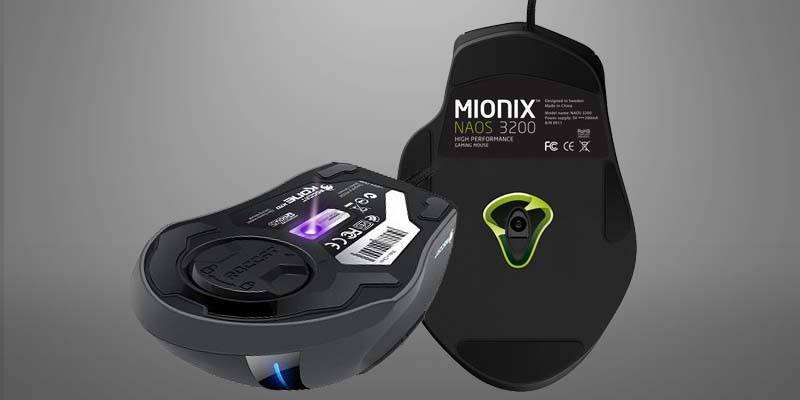Stop! Before you rush off to spend your hard-earned money on a new gaming mouse, you’ll want to make sure you know the key differences between the varying technology types available today. Any pc gamer who wants to improve their gameplay needs the absolute best gaming mouse they can get.
But what is the difference between an optical mouse vs laser mouse? Does one have an advantage over the other? And which one is better for gaming?
Let’s explore the answers to these questions below.

Gaming Mice vs. Regular Mice
Regular mice and gaming mice both serve the same purpose. The job of a regular computer mouse is to translate the physical movements you make with the device to the cursor on the screen. Generally speaking, they perform the same function – one does it better.
While you can use a standard desktop mouse to get your game on, in most cases, it will underperform compared to a mouse designed specifically for that purpose.
A gaming mouse is designed from the ground up to meet the needs of competitive gameplay and includes varying features and functionality to enhance the experience.
There are different types of gaming mice, too. For example, FPS gaming mice are designed to help improve precision and accuracy during twitch gameplay, while MMO gaming mice provide extra buttons for easy access to important skills and abilities.
Each type has different features, including programmable buttons, ergonomics to complement different mouse grips and more precise sensors.
What is the Difference Between a Laser and Optical Mouse?
Optical and laser sensors are the two most common types of sensors you can get in any desktop mouse these days. They are essentially the same, but the main difference is that an optical mouse illuminates the surface with an LED, and in some cases, an infrared LED.

While on the other hand, a laser mouse uses… you guessed it: a laser.
Both sensors are designed to take thousands of pictures of the surface each second and relay that physical movement to a position on the screen.
But if both types of sensors perform similarly, what makes one better?
Pros and Cons of Optical and Laser Sensors
Unlike the optical sensor, which only scans the surface it sits on, a laser sensor is so sensitive it looks deep into the surface for microscopic details, making it compatible with nearly any type of surface – even glass or transparent surfaces.
Unfortunately, being overly sensitive can be a double-edged sword. It depends on which sensor is used, but most of the laser sensors installed in mice are more susceptible to speed-related accuracy variance, or what is commonly known as “mouse acceleration.”
Why? Because, more often than not, it’s built right into the hardware.
An optical gaming mouse doesn’t suffer from hardware acceleration to the same degree as a laser mouse, making it a far more accurate and reliable option for gaming. The tradeoff, however, is that optical mice aren’t quite as sensitive, so the types of compatible surfaces are more limited.
What is Mouse Acceleration?
When you swipe your mouse across the mousepad quickly and then move it back to the starting position, the cursor on the screen should also return to its original position. If it doesn’t, the mouse is displaying some mouse acceleration.
In simpler terms: the movement is too unpredictable to be precise.
Optical Mouse vs Laser Mouse – Which is Better for Gaming?
Until recently, laser mice always had a higher resolution, or “DPI,” than competing optical mice. They could track more on-screen pixels per inch relative to your hand movements. With recent technological advances in gaming monitors and larger display resolutions, having a laser mouse seemed more future-proof.
Additionally, their ability to track on nearly any kind of surface with great accuracy made them particularly attractive to people who wanted the ability to use them on surfaces like glass or without a mousepad.
But the amount of built-in mouse acceleration concerns gamers who rely on consistently precise movements during gameplay. And since optical mice like the Logitech G900 or G502 (to name a few) have caught up to lasers in the DPI race, the choice seems pretty clear:
Optical mice are better for gaming than laser mice.
How to Improve Mouse Performance
Whether you use an optical or laser mouse, it’s essential to use them on a compatible surface and adjust mouse acceleration settings for optimal tracking.
- If you use an optical mouse, ensure you get a quality mouse pad like the SteelSeries QcK. Some patterns or graphic designs are acceptable, but solid colors like black or white will ensure the most accurate tracking.
- If you use a laser mouse, you can use it on nearly any surface except cloth. Cloth mouse pads have millions of microscopic fibers the laser will pick up on while scanning the surface. These fibers will lead to too much “noise”, which adds to acceleration.
- Also, no matter what mouse you use, ensure you disable mouse acceleration in your operating system. Here’s a good tutorial on disabling it in Windows and another for Mac.
Conclusion
As you have learned, the differences between an optical mouse vs laser mouse may be few, but the competitive gamer will most likely prefer the consistent performance of optical mice over laser alternatives. What about you?

